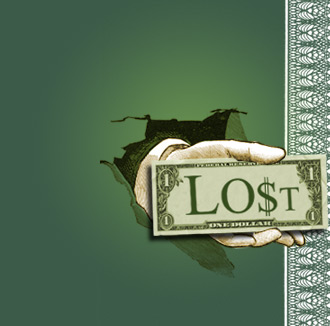
What's in the Bank These Days?
Notched sticks are one of man's first inventions. They came after discovering how to use tools for hunting, but before inventing the wheel. And so many millennia later, we still count this way when we need to. Men working in Southern California used to keep track of their days by cutting a line for each day in a block of wood; they used a deeper or thicker line at the end of each week, and a cross at the end of each fortnight. Cowboys made notches in their gun stocks for each buffalo they killed — or for each Indian. During both world wars pilots drew decals on their planes to mark the number of enemy planes they had downed, another kind of tallied one-to-one record. In England, notches on wooden batons stood for varying amounts of pounds sterling. Charles Dickens, in a speech given in 1855, told about
a savage mode of keeping accounts on notched sticks … introduced into the Court of Exchequer, [where] the accounts were kept, much as Robinson Crusoe Kept his calendar n the desert island …. Official routines inclined to these notched sticks, as if they were pillars of the constitution, and still the Exchequer accounts continued to be kept on certain splints of elm wood called "tallies." In the reign of George III an inquiry was made by some revolutionary spirit, whether pens, ink, and paper, slates and pencils, being in existence, this obstinate adherence to an obsolete custom ought to be continued, and whether a change ought not to be effected. All the red tape in the country grew redder at the bare mention of this bold and original conception and it took till 1826 to get these sticks abolished.
The English Royal Treasury had kept its accounts on tally sticks since the twelfth century. Income, expenditures, taxes — all were notched on tallies. And more: double-notched sticks were issued; half the stick, with one set of notches, was redeemable (assuming it matched — or tallied) for cash through the Treasury, which held the matching piece. Thus, the written (or notched) certificate payable to the bearer after it had agreed with its security: a check. The stock and dividend also trace back to the Treasury's tally sticks — the stock was the specially marked tally stick held by anyone who lent money to the Bank of England, and thus became a share — or stock-holder. A dividend originally was a tallia Dividenda — a "stick to be divided" — redeemable through the Treasury.
The Treasury's Court of the Exchequer didn't take its name from back checks. Instead, its named after the cloth that covered the table in the room where local administrators came to settle accounts with the Crown. The cloth was checkered so that counters could be placed in squares that corresponded to various accounts: the final sum was entered both in an account book and on a tally stick — and everyone could understand the process, even if they didn't know how to read or write.
In 1782, it was decided that tally sticks would no longer be issued by the Royal Treasury, but they remained valid until 1826. In 1834, the process of burning the vast numbers of outdated tally sticks began in the furnaces beneath the Houses of Parliament. Unfortunately, the fire was so intense that the Parliament buildings themselves caught fire and went up in flames. In his 1855 speech, Dickens continued his description of the Court of the Exchequer's use of tallies to keep accounts. "It came to pass that [the tallies] were burnt in a stove in the House of Lords. The stove, overgorged with these preposterous sticks, set fire to the paneling; the paneling set fire to the House of Lords. The House of Lords set fire to the House of Commons; the houses were reduced to ashes; architects were in to build others; we are now in the second million of the cost thereof; the national pig is not nearly over the stile yet; and the little old woman, Britannia, hasn't got home to-night."
Britain wasn't alone in its use of notched sticks. Tally sticks were used in Germany, in Switzerland, throughout Scandinavia, in Indochina, and in a host of other places. The word for contract in Chinese is written with a character made up of three parts: the character for a tally stick on the left, knife on the right, and under both, another character that means large. Thus, a contract is a big tally stick.
In The Universal History of Numbers, Georges Ifrah writes about a French bakery where, until as recently as the 1970s, tally sticks were used as credit cards of a sort. Two small pieces of wood, called tailles, were notched every time a customer bought a loaf of bread; the baker kept one plank, and the customer took the other home with the bread. At the end of the week, the two planks were matched — the notches had to be equal — and the bill was settled.
Excerpted from Perfect Figures: The Lore of Numbers and How We Learned to Count by Bunny Crumpacker. Copyright © 2007 by the author and reprinted by permission of Thomas Dunne Books, an imprint of St. Martin's Press, LLC.
BACK TO TOP
$ $ $ $ $ $ $ $ $ $ $ $ $ $ $ $ $ $ $ $ $ $ $ $ $ $ $ $ $ $ $ $ $ $ $ $ $ $ $ $ $ $ $ $ $ $ $ $ $ $ $ $ $ $ $ $ $ $
|
 Print
Print